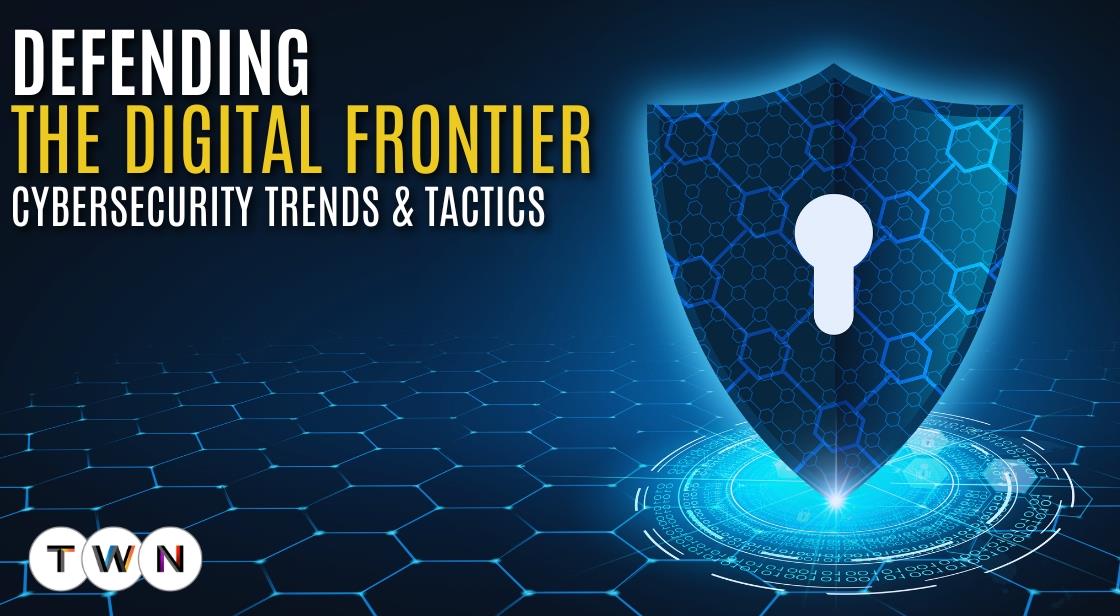Defending the Digital Frontier: Cybersecurity Trends and Tactics

Blog Post
Analyzes how cybersecurity is changing in the age of technology. The digital frontier has grown due to the quick development of technology, bringing with it both new opportunities and previously unheard-of difficulties.
This blog explores the most recent developments in cybersecurity, such as new dangers and creative risk-reduction strategies.
Cyber risks are present in many forms in the connected world of today, from ransomware events and data breaches to sophisticated malware and phishing attempts. Proactive protection techniques are necessary for cybersecurity workers to keep ahead of the curve as fraudsters grow more skilled.
This article also emphasizes how crucial it is to address cybersecurity from several angles, utilizing both technology and human-centered strategies. Organizations must use a variety of strategies to protect their digital assets, from installing strong encryption protocols and access restrictions to utilizing artificial intelligence and machine learning algorithms to improve threat detection capabilities.
This topic also discusses the reinforcement of defenses and reduction of the impact of cyberattacks through incident response plans and cybersecurity awareness training. Digital dangers are always changing, and people and businesses may better defend themselves and safeguard the digital frontier by keeping up with the newest cybersecurity trends and implementing efficient defensive strategies.
Exploring Cybersecurity Trends and Tactics
What is Cyber Defense: Trends & Tactics
Cyber defense refers to the methods, tools, and techniques used to defend data, networks, and digital systems from online threats and assaults. The ever-changing digital ecosystem of today needs cyber protection to adjust to new trends and techniques employed by bad actors.
The use of AI and machine learning for complex threat detection, the deployment of zero trust architecture to reduce the possibility of insider threats, and the focus on proactive threat hunting to identify and remove possible threats before they manifest are some notable developments in cyber defense.
Cyber defense strategies extend from more complex methods like penetration testing, incident response planning, and continuous security monitoring to more conventional ones like firewalls and antivirus software. All things considered, cyber defense is a dynamic subject that needs constant innovation and attention to detail to successfully protect digital assets and uphold cyber resilience.
Protecting the Digital Frontier
Defending the digital frontier involves protecting the enormous and continuously growing domain of digital technology and information from an array of cyberattacks. This involves guarding against malicious activity, illegal access, and breaches on networks, systems, devices, and data.
Here's a summary of the main points:
Risk Assessment: identifying and assessing any weak points and risks to digital information.
Security Measures: using firewalls, intrusion detection systems, antivirus programs, and encryption as robust security measures.
User Education: Educate people on cybersecurity best practices to raise awareness and thwart social engineering scams.
Incident Response: Establishing protocols and procedures for timely detection, containment, and mitigation of security incidents.
Continuous Monitoring: Employing tools and technologies for real-time monitoring and threat detection to identify and respond to emerging threats promptly.
Compliance: Ensuring compliance with relevant regulations and standards to maintain data integrity and privacy.
Adaptability: Continuously evolving security strategies and technologies to address new and evolving cyber threats effectively.
Collaboration: Engaging in information sharing and collaboration with industry peers and cybersecurity professionals to stay updated on emerging threats and best practices.
Protecting the digital frontier requires a comprehensive and proactive approach to mitigate risks and ensure the security and resilience of digital assets and infrastructure.
Latest Trends in Cybersecurity
Ransomware Attacks: A concerning trend in cybersecurity involves the increasing frequency and sophistication of ransomware attacks targeting businesses, organizations, and individuals worldwide.
These attacks involve cybercriminals encrypting valuable data and demanding ransom payments for its release, posing significant financial and operational risks to victims.
Zero Trust Architecture: Another trend is the adoption of Zero Trust Architecture, which assumes that all users, devices, and networks are untrusted and continuously verifies access requests based on multiple factors.
This approach enhances security by minimizing the risk of unauthorized access and lateral movement within networks.
Cloud Security: With the widespread adoption of cloud computing, ensuring robust security measures for cloud-based services and data storage has become a top priority.
Organizations are implementing advanced security protocols and technologies to protect sensitive information and prevent unauthorized access or data breaches.
AI-Powered Threat Detection: Leveraging artificial intelligence (AI) and machine learning algorithms for threat detection and response is a growing trend in cybersecurity.
These technologies enable automated analysis of large datasets to identify and mitigate potential security threats in real-time, enhancing overall cyber defense capabilities.
Identity and Access Management (IAM): IAM solutions play a crucial role in cybersecurity by managing user identities, enforcing access controls, and ensuring compliance with security policies.
The latest trends in IAM focus on implementing multi-factor authentication, adaptive access controls, and continuous monitoring to enhance identity security and prevent unauthorized access to sensitive resources.
Tactical Cyber Defense
Tactical cyber defense refers to the proactive and reactive measures taken to protect digital assets, networks, and information systems from cyber threats.
Here's a breakdown of key points:
Threat Detection: Implementing tools and techniques to identify and analyze potential cyber threats in real-time.
Incident Response: Developing and practicing response procedures to effectively mitigate and recover from cyber attacks.
Vulnerability Management: Regularly assessing and remediating weaknesses in systems, applications, and configurations.
Access Control: Implementing strict authentication and authorization mechanisms to prevent unauthorized access to sensitive data and resources.
Security Awareness: Educating employees and users about cyber threats, best practices, and their role in maintaining security.
Continuous Monitoring: Monitoring network traffic, system logs, and user activities to detect and respond to anomalies and suspicious behavior promptly.
Patch Management: Ensuring timely application of security patches and updates to address known vulnerabilities.
Threat Intelligence: Leveraging information about current cyber threats and attack techniques to enhance defensive strategies.
Collaboration: Engaging in information sharing and collaboration with industry peers and security communities to stay informed about emerging threats and effective defense strategies.
Regular Training and Exercises: Conduct regular training sessions and simulated cyber attack exercises to test and improve the effectiveness of cyber defense measures.
Ransomware Resilience: Defending Against Data Hijackers
An explanation of ransomware is as follows: ransomware is a kind of malicious software that blocks access to data or a computer system until a certain amount of money is paid.
Backup and Recovery: Regularly backing up data and storing it securely offline can mitigate the impact of a ransomware attack. This guarantees that data may be recovered without having to pay a ransom, even in the event that it is encrypted by hackers.
Employee Training: Educating employees about the dangers of phishing emails and suspicious links can prevent ransomware infections. Workers have to get phishing attempt detection training so they can report attempts as soon as they happen.
Endpoint Security: Implementing robust endpoint security solutions can detect and block ransomware threats before they can encrypt files on endpoints such as computers and mobile devices.
Keeping software and operating systems up-to-date with the latest security patches can prevent vulnerabilities from being exploited by ransomware attackers.
Having a well-defined incident response plan in place can help organizations respond effectively to ransomware attacks, minimizing downtime and data loss.
Network Segmentation: Segmenting networks can limit the spread of ransomware within an organization's infrastructure, preventing it from affecting critical systems.
Leveraging threat intelligence sources can provide insights into emerging ransomware threats and help organizations stay one step ahead of attackers.
Collaborating with law enforcement agencies and cybersecurity organizations can aid in investigating and mitigating ransomware attacks, as well as tracking down and apprehending perpetrators.
Frontline Cyber Defense
Proactive Measures Against Cyber Threats
The term "frontline cyber defense" describes the proactive methods and processes used by businesses to defend their networks, systems, and digital assets from online attacks. It entails utilizing a variety of tools, procedures, and methods to successfully identify, stop, and handle cyberattacks.
Strong cybersecurity measures including intrusion detection systems, firewalls, antivirus programs, and encryption techniques are included in this. To remain ahead of developing cyber threats, frontline cyber security also includes incident response planning, threat information collecting, and ongoing monitoring.
Implementing Necessary Security Measures in Real Time
As frontline defenders, organizations frequently use qualified cybersecurity specialists who monitor and analyze network traffic, spot possible vulnerabilities, and put in place the required security measures. In order to secure sensitive data, preserve operational continuity, and guard against financial and reputational harm, frontline cyber defense is essential as cyber attacks continue to develop and get more complex.
What is the role of Tactics in Cybersecurity?
Tactics in cybersecurity refer to specific strategies and actions employed to protect digital systems, networks, and data from various cyber threats and attacks.
Cybersecurity Tactics: Balancing Proactive and Reactive Measures
These strategies cover a wide variety of preventative and corrective actions intended to reduce risks and the effects of any breaches. Common strategies include putting in place strict access controls, patching and updating software on a regular basis, conducting security audits and assessments, deploying intrusion detection and prevention systems, protecting data, and educating staff members on cybersecurity best practices.
"Incident Response: Essential Cybersecurity Strategy" Furthermore, incident response strategies—which include isolating impacted systems, carrying out forensic investigation, and putting repair procedures in place—are essential for efficiently managing and mitigating security events when they arise. In general, cybersecurity strategies are dynamic and ever-changing to accommodate new risks and weaknesses in the digital environment.
Security Awareness Training: Building a Cyber-Resilient Workforce
Employee education on numerous cybersecurity topics is the goal of security awareness training, which is a proactive strategy. The goal is to equip individuals with the knowledge and skills necessary to recognize, avoid, and respond to cyber threats effectively.
This training covers topics such as identifying phishing attempts, practicing safe browsing habits, creating strong passwords, understanding social engineering tactics, and recognizing signs of malware infections.
Employees become the first line of defense against cyber threats, contributing to a culture of cybersecurity awareness and vigilance within the organization. Ultimately, this leads to enhanced protection of sensitive information, safeguarding the organization's reputation, and ensuring business continuity in the face of evolving cyber threats.
Understanding Threat Landscape: Security awareness training begins with educating employees about the various cyber threats facing organizations today, including phishing attacks, malware, ransomware, and social engineering tactics.
Recognizing Suspicious Activity: Employees learn how to identify signs of potential cyber threats such as suspicious emails, unexpected attachments, or unusual website requests. They are trained to report such incidents promptly to the IT or security team.
Best Practices for Data Protection: Training emphasizes the importance of safeguarding sensitive information and following data protection protocols, including using strong passwords, encrypting data, and securely handling confidential documents.
Safe Internet and Email Practices: Employees are educated on safe internet browsing habits and how to navigate online environments securely. This includes avoiding clicking on unknown links, downloading files from untrusted sources, and sharing sensitive information over email.
Mobile Device Security: Training covers best practices for securing mobile devices used for work purposes, including enabling passcodes, installing security updates, and avoiding public Wi-Fi networks for sensitive transactions.
Incident Response Procedures: Employees are trained on the organization's incident response procedures, including whom to contact in case of a security breach, how to contain the incident, and steps to mitigate further damage.
Regular Updates and Reinforcement: Security awareness training is an ongoing process, with regular updates and reinforcement sessions to keep employees informed about the latest cyber threats and best practices for cybersecurity.
Supply Chain Security: Assessing and Monitoring Third-Party Risks
Supply chain security involves assessing and mitigating risks associated with the interconnected network of suppliers, vendors, and service providers that contribute to the production and distribution of goods and services.
Importance of Assessing Third-Party Risks
Assessing third-party risks is crucial as organizations often rely on external partners for various aspects of their operations. This includes evaluating the security practices and vulnerabilities of third-party suppliers and vendors to ensure they meet the organization's security standards.
Monitoring third-party risks involves ongoing surveillance and evaluation of external partners to identify any changes or developments that may pose security threats to the organization's supply chain. This may include conducting regular audits, implementing contractual obligations related to security standards, and leveraging technology solutions for continuous monitoring and risk assessment.
By assessing and monitoring third-party risks effectively, organizations can strengthen their supply chain security and mitigate potential vulnerabilities that could impact the integrity, confidentiality, and availability of their products and services
What is the meaning of Cyber Defense Strategies?
Cyber defense strategies refer to proactive measures taken by organizations to protect their digital assets, networks, and systems from cyber threats. These strategies encompass a variety of approaches, including technical solutions, policies, procedures, and workforce training.
Integrated Tools and Strategies
Organizations often employ a multi-layered approach to cyber defense, combining tools such as firewalls, antivirus software, and intrusion detection systems with strategies like risk assessment, access control, and incident response planning.
Effective cyber defense strategies also involve continuous monitoring of networks and systems for potential vulnerabilities and threats, as well as regular updates and patches to mitigate known weaknesses. Additionally, educating employees about cybersecurity best practices and fostering a culture of security awareness are crucial components of any comprehensive cyberdefense strategy.
By implementing robust cyber defense strategies, organizations can minimize the risk of cyber attacks, protect sensitive data, and ensure the integrity and availability of their digital assets.
You May Like
EDITOR’S CHOICE












